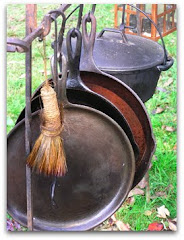As I've become more interested in cast iron cookware, I've found that there are so many different items that fall into this category. One item that has intrigued me recently is the cast iron tea kettle.
In cast iron there are different types and brands of tea kettles from different from countries. Besides American made cast iron tea kettles, Japanese kettles and Old Dutch kettles seem to be the most readily available. I noticed that the Japanese cast iron tea kettles are made in different weights of cast iron; I've seen them in 10 oz., 24 oz., 32 oz. and 45 oz. weights. The Old Dutch cast iron tea kettles I've seen are similar in weights to the Japanese kettles. These tea kettle weights in ounces of cast iron are 28 oz., 34 oz., 38 oz. and 48 oz. Because cast iron tea kettles are the heaviest (and thickest) of the tea kettles made (in comparison to glass tea kettles, stainless tea kettles & copper tea kettles) it's good to know they can be found in various sizes and weights. It should be easy to find something you prefer in both style and weight.
Types of American made cast iron tea kettles include hobnail - small & large hobnails - tea kettles, hand-painted enamel cast iron (many depicting scenes of the old farming countryside), pre-seasoned cast iron kettles, which should not rust because of the pre-seasoning (though it may need to be re-seasoned sometime down the road) and cast iron kettle humidifiers.
Rust can be a problem for cast iron tea kettles, but if the rust can be kept from these kettles, they will probably be the most durable of tea kettles (also compared to the other types I listed above). When boiling water using cast iron tea kettles, a sort of protective layer of minerals will build up on its base overtime. With this layer, these kettles will not easily develop rust.
If, by chance, your cast iron tea kettle does develop rust (to prevent rusting, keep your cast iron kettle dry as much as possible, and take out remaining water directly after boiling), you can try the following process to try and cure it: boil in it some water mixed with baking soda and lemon juice.
As far as colors and designs go, the Old Dutch cast iron tea kettles seem to have the most variety of styles. They have a list of names for their styles of teapots: Prosperity, Nobility, Symmetry, Mythology, Purity and Tranquility. Each style has its own shape, colors and intricate designs on the sides of the teapots - the colors being rather beautiful: pale blue, mustard, black, chestnut brown and red. Actually, the Japanese cast iron tea pots are quite colorful and beautiful too, but I think I fell for the names of the Old Dutch styles! As with anything else, personal preference is as they say, "beauty is in the eye of the beholder."
Subscribe to:
Post Comments (Atom)

No comments:
Post a Comment